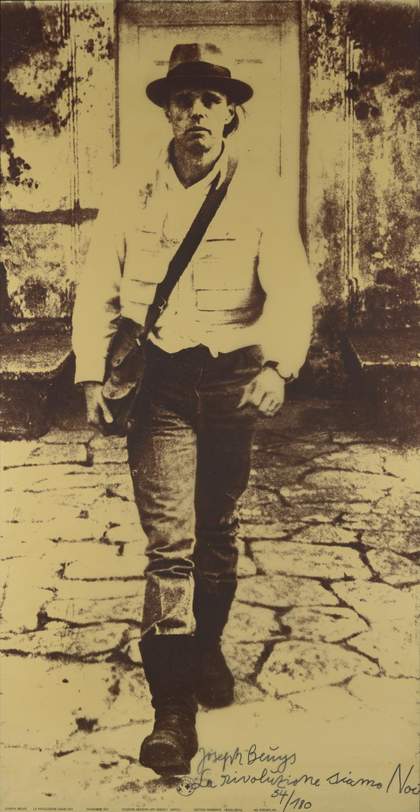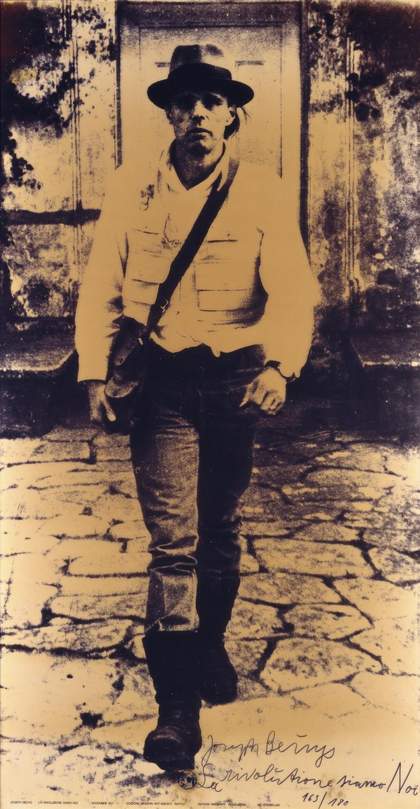It is not often that one roams through a museum and encounters the same artwork twice. Yet this was the visitor’s experience at Tate Modern, London, in 2016, when Joseph Beuys’s silkscreen poster La Rivoluzione Siamo Noi (We Are the Revolution) 1972 (fig.1) appeared in the context of ARTIST ROOMS, and its screenprinted counterpart We Are the Revolution 1972 (fig.2) was shown in a separate display of social and political art.1 In this image Beuys shows himself as an activist, striding towards the viewer. The artist, who was dismissed from his position as Professor of Monumental Sculpture at the Düsseldorf Academy that same year, addresses his companions in a way that could suggest that we should all become revolutionaries.2 Did he wish for others to copy him, following closely in his footsteps, or to go their own way in the wake of his thinking? Did he want others to leave universities in the way that he did, while showing us that he had entered another institution – that of the museum?
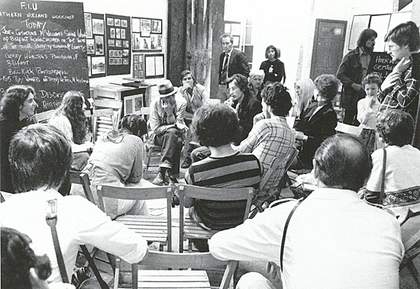
Fig.3
Discussion at an FIU workshop during Documenta 6, Kassel, 1977
© Documenta Archiv/Joachim Scherzer
One of Beuys’s most revolutionary projects, shaped with some friends in the early 1970s at around the time that Beuys made the two prints shown at Tate, was his Free International University for Creativity and Interdisciplinary Research (FIU). This was a counter-university, a teaching and learning space that was designed to make revolutionary ambitions come true – or at least to offer Beuys a substitute for his recently terminated position at the Düsseldorf Academy (fig.3). This paper argues that the FIU came about in a manner and within a context that makes it less than unique, but that it has nonetheless remained foremost in artists’ and art historians’ minds when they think about instituting alternative forms of education. This is arguably because the FIU proffered an open invitation to all: it was pedagogically and institutionally relatively undefined, although conceptually – as an artwork – it was clearly embedded in Beuys’s thinking and doing, as well as in his other work. With this confluence of art, art history and activism as its basis, what did the FIU become in the hands of Beuys’s followers?

Fig.4
List of artists’ university projects established since the founding of the FIU
Nearly half a century after its founding, it is time to ask about the artistic legacy of Beuys’s original initiative. We can begin with a list of some of the well-known counter-educational institutions founded by artists since the establishment of the FIU, which stands at the list’s beginning as the first example of artists’ universities (fig.4).3 The following projects, as identified by artist, writer and activist Gregory Sholette, can be added to this:
The Public School, Petersburg Street University, Baltimore Free School, Stockyard Institute, 16 B – add to this list the School of Missing Studies in the Balkans, Red76’s Laundry Lecture Series in Portland, Oregon, transit free school in Austria and Eastern Europe, The School of Decreative Methodologies at Basekamp space in Philadelphia, or artist Nils Norman’s University of Trash and Exploding School projects, and the volume of recent, ‘bottom-up’ pedagogical initiatives begins to become clear. There are even reports that behind the tenth-floor elevator machine room at Saint Martins College of Art in London students gather to clandestinely re-appropriate their education, unbeknownst to program administrators.4
Artists’ university initiatives are indeed proliferating and are not easily defined as existing either ‘inside’ or ‘outside’, visibly or invisibly. Art historian and critic Sven Lütticken calls them alter- and para-institutions and has considered them under the heading of ‘practices of (in)visibility in contemporary art’. Lütticken observes:
a kind of generalised aesthetic practice that thrives on a pragmatic stretching of boundaries or on the exploitation of the increasing permeability of both institutions and social fields. Such aesthetic practice refuses to fit into the time-honoured opposition between, on the one hand, the avant-garde’s transgression of the boundaries of art and its attempts to merge art with life and, on the other, institutional critique’s insistence on operating immanently and critically within the institutional structures of art. Neither immanence nor transgression is quite its old self any more.5
With Lütticken’s comments in mind, this article will first frame the FIU in its time and place of origin – Germany during the Cold War – in order to then trace (and at times speculate about) the FIU’s relationship with artist-led educational institutions that have been established subsequently. This will take into account the virtual explosion of such cases since around 2000. A selection of the examples listed above will be discussed here – necessarily privileging networks into which I have closer insight – to help focus on the question of the FIU’s ongoing currency and the potential necessity for artists to (re-)enter the public university.6
The emphasis here is on the aims and approaches of the FIU, rather than Beuys’s own pedagogy. While anti-authoritarian in intention, in a number of instances Beuys’s teaching seems to have relied on his charisma and focused on him as an individual.7 In setting up the FIU, by contrast, he involved others far more actively, and this paper will draw out some of the characteristics of this collaborative approach and how they have been picked up and used in subsequent artists’ university projects. These characteristics include de-emphasising the role of the author by using ‘stealth practices’ and creating a counter-canon of liberating literary texts, such as works by James Joyce; and bringing artists together through the use of rhizomatic networks in European peripheries – including behind the Iron Curtain – rather than in physically existing artist-led schools.
These strategies used by Beuys and the FIU were arguably social and political rather than didactic in approach. In my view, this demands that the present essay follow the networked form that his approach embodied. This paper therefore employs a Beuysian format of ‘braiding’ elements (motifs, approaches, people, places, (art)works) together. It also uses the work of cultural historian Shannon Jackson to address art, art history and the social realm together, as Beuys did.8
Origins and parallels
The FIU has a varied history and pre-history, leading to uncertainties about the exact date of its founding.9 We could take the manifesto, co-authored in 1973 by Beuys and the writer Heinrich Böll, as a starting moment.10 Beuys travelled through Ireland in 1974, searching for premises for the FIU in Dublin and Derry. While many followers associated themselves with the FIU name and Beuys’s already established format of long discussions in art contexts became bracketed under the FIU banner, no formal university structures were established: no right to give diplomas was procured, nor were dedicated buildings opened or prescribed activities and curricula drawn up.11 Loose circles of friends and fellow artists, formalised by the establishment of regional associations and the employment of individual members by various institutions, were the main forms in which the FIU existed, and in which they continue to exist to this day. For instance, a 1979 leaflet lists addresses for the FIU in Düsseldorf, London, Dublin, Belfast, and Pescara in Italy.12 These included private addresses and art spaces, such as the Art and Research Exchange in Belfast.
To say that the FIU no longer exists, or is still only comprised of Beuys’s friends, is untrue. But was Beuys the originator of artists’ university projects? Art historically speaking, it seems quite likely that he was – if we set aside the broader history of art academies, often also established by artists. In the case of the academies, the impetus was to establish something official and hegemonic in order to garner a higher status for art than was achieved when training in guilds. By contrast, the artist-led university projects listed above are characterised by a desire to create an alternative form of teaching and learning, even if at times it was moderated by the inherent paradoxes of institutional critique.13 Yet even if we take the already problematised wish to create an alternative as a central criterion of these projects, Beuys may not qualify for the role as initiator: if, according to his own dictum that ‘Everybody is an artist’, other alternative or dissident educational initiatives need to be considered, and there are certainly more candidates and genealogies emerging into view.14
Connecting the proliferation of artists’ university initiatives to the context of widespread and recurring university protests in many countries from around 2010 onwards may provide a cue for the present argument about the FIU’s currency. South African novelist and academic J.M. Coetzee commented on the position of an activist colleague in 2013:
I could not be more strongly on your side in your defence of the humanities and of the university as the home of free enquiry … We need institutions where teachers and students can pursue unconstrained the life of the mind …. In institutions of higher learning in Poland, in the bad old days, if on ideological grounds you were not permitted to teach real philosophy, you let it be known that you would be running a philosophy seminar in your living room, outside office hours, outside the institution. In that way the study of philosophy was kept alive. It may be something along the same lines will be needed to keep humanistic studies alive in a world in which universities have redefined themselves out of existence.15
The FIU originated in those ‘bad old days’ in a divided Europe, although on the Western side, where in 1968 and thereafter many of those studying and working in universities such as the Düsseldorf Academy – Beuys’s workplace – argued that the state was not democratic enough, not distinct enough from the totalitarian practices of the Nazis. This debate was also held in educational institutions in Eastern European countries. Yet Beuys’s decision to leave the university system was not voluntary: in October 1972 the artist was dismissed from his position at the Düsseldorf Academy for his involvement in sit-ins and for disregarding the usual admittance procedures for students (he permitted anyone to enter his class). A passionate teacher, Beuys then co-founded the FIU with Böll and artist Klaus Staeck, among others, as a new way of framing and practising (or performing) art. Beuys used many occasions on which he was invited to ‘merely’ exhibit objects as an opportunity to teach and discuss: from a 1974 drawing exhibition in Belfast combined with a three-and-a-half-hour lecture (figs.5 and 6), to Documenta 6, 1977, where his installation Honey Pump in the Workplace was accompanied by talks (or vice versa), a Migration Workshop and conversations that lasted 100 days.16 In 1975 Caroline Tisdall, a journalist at the Guardian, worked with Beuys to write a funding application to the European Economic Community (EEC), in order for the FIU to be implemented in Dublin or Derry and for it to be seen in a wider (Western) European context, though this bid was ultimately unsuccessful.17
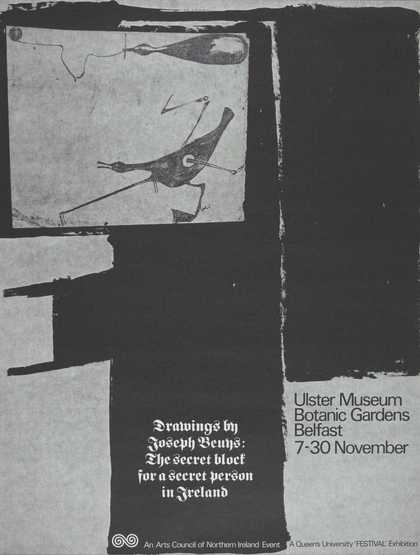
Fig.5
Joseph Beuys
Drawings by Joseph Beuys: The Secret Block For a Secret Person in Ireland. Ulster Museum Botanic Gardens, Belfast 1974
Tate and National Galleries of Scotland, Edinburgh AR00788
© DACS 2019
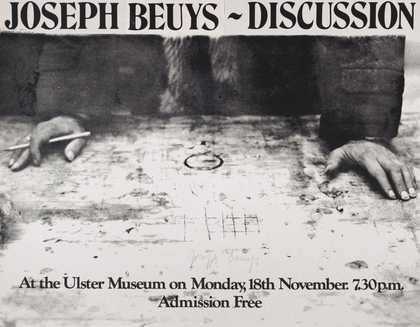
Fig.6
Joseph Beuys
Joseph Beuys: Discussion. The Ulster Museum, Northern Ireland 1974
Tate and National Galleries of Scotland, Edinburgh AR00765
© DACS 2019
It is my contention that Beuys was well aware of the parallel educational world of dissidents in Eastern Europe, who tried to counter tendentious if not propagandistic and paramilitary teaching.18 Beuys had networks there in the 1970s and 1980s, not least through Edinburgh gallerist Richard Demarco. Following his dismissal from Düsseldorf, the counter-educational formats developed in Eastern Europe clearly appeared attractive to Beuys. What is even more important than insisting that Beuys’s FIU initiative was not so unique after all is to state that the FIU was in turn inspirational for Central and Eastern Europeans: the canonical Western artist with his initiative to democratise education could serve as a partial justification for what Central and Eastern European artists were doing in the margins of legality in their contexts.19 Through Beuys’s example, counter-educational initiatives (broadly understood) in Eastern Europe could be seen as not so unilaterally directed against their own regimes: their practices had a well-exhibited, canonical precedent in art and interdisciplinary practice internationally. For many artists excluded from membership of their countries’ artists’ organisations – those who were prohibited from working on official projects, exhibiting in official spaces and ‘being’ artists – it was important to practice according to an expanded concept of art, so as to still be able to remain active and creative in the Beuysian sense in which everybody is not only an artist, but also a teacher. Beuys thus not only provided support by echoing the dissidents’ establishment of alternative educational formats, but also contributed a notionally overarching framework: an expanded concept of art that included education. This was necessary in order for artists to avoid, as far as possible, the political restrictions imposed in Eastern Europe.
One example of artists in Eastern Europe using education as a strategic (performance) tool is that of Game on Morel’s Hill by KwieKulik (Przemyslaw Kwiek and Zofia Kulik).20 Taking a group of students onto snow-covered fields with two pieces of fabric – one red and one white – in 1971 could have been understood as a dissident performance or demonstration. As an educational situation, the performance took on an ‘official’ dynamic; staged as an excursion to aide plein air art practice, it provided a conventional framework through which it could be understood and thus arguably rendered the artists safer than if they had performed on their own, or without the red ‘flag’ that underscored their claim to be official. White fabric added a national element (Poland’s flag is red and white) and simultaneously subverted all flag-waving triumphalism (as a sign of surrender) – with the snowy background acting as a visual ‘ally’ of a pacifist attitude of capitulation.21
Counter-educational formats were also developed beyond Europe in the 1970s. As early as 1970, Maurice Stein and Larry Miller published their Blueprint for Counter Education with CalArts (California Institute of the Arts), a strong and ‘official’ yet innovative institutional partner.22 It is not surprising that information about such projects is easily accessible and visible today, as compared with the alternative educational institutions that were developed in Central and Eastern Europe, which needed to remain outside of institutions and were rarely documented so as to avoid generating incriminating evidence. When Tom Holert curated the exhibition and symposium Learning Laboratories: Architecture, Instructional Technology, and the Social Production of Pedagogical Space Around 1970 at BAK (basis voor actuele kunst) in Utrecht in 2017, it was exciting to see a wealth of counter-educational initiatives and architectural projects displayed, such as the one from CalArts. However, Eastern European perspectives and artists’ projects were not foregrounded. This was partly because of scarce surviving information, and partly due to the fact that the focus of the exhibition was architectural – erecting school buildings was not possible for dissident architects in the East, apart from through models in their own ‘kitchen exhibitions’.23
The remainder of this article turns to a number of examples of counter-educational projects that seem – in different and often loose ways – related to Beuys’s thinking and the FIU, namely those by Thomas Hirschhorn, Ahmet Ögüt, Dora Garcia, the Solidarity Academies in Turkey, ALBA, Antoni Muntadas and Eyal Weizman. As will be shown, these initiatives have formed a legacy for the FIU, while also addressing their own needs and taking their individual stance towards – and away from – both Beuys and established institutions.
Countering the canon
Thomas Hirschhorn, a fan and follower of Beuys,24 may not appear to fit in the present context: his temporary wooden structures, which function as libraries and reading/meeting/teaching rooms and are placed in disadvantaged neighbourhoods in places such as Kassel and Amsterdam, do serve as educational hubs, but they are not intended by the artist to be lasting, surviving only as documented art projects. In this regard, however, these projects echo one aspect of the FIU: having abandoned the search in Ireland for premises for the university in 1974, Beuys changed his conceptualisation of the FIU, and began instead to think of it as a network of people who would be ‘based’ at their private addresses or workplaces and could be called upon to institutionally manifest the organisation through events and gatherings.25 This would complement the informal learning of those in the FIU’s sphere, hopefully kindling interests and intellectual needs that could also be met by other educational institutions or groups.26
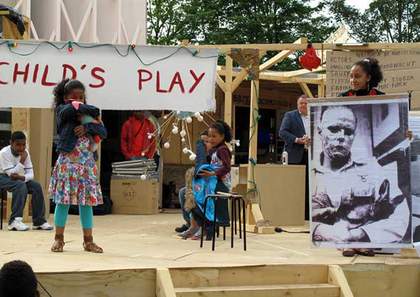
Fig.7
Thomas Hirschhorn
Child’s Play, performance at The Bijlmer Spinoza-Festival, Amsterdam, 2009
Photo © Anna Kowalska
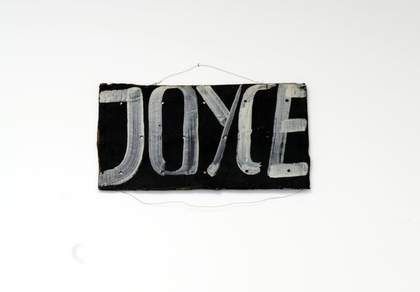
Fig.8
Joseph Beuys
JOYCE 1961
Paint on cardboard, wire
450 x 650 mm
Private collection
© DACS 2019

Fig.9
Maurice Stein, Larry Miller and Marshall Henrichs
Poster from Stein and Miller’s Blueprint for Counter Education 1970
On a formal, art historical level, Hirschhorn’s The Bijlmer Spinoza-Festival, which was held in Amsterdam over two months in 2009, provides a clear Beuysian echo. During the project, cardboard signs with names of canonical writers, thinkers and artists were presented by children, accompanied by a large-scale photocopied image showing Beuys during his 1965 performance Explaining Pictures to a Dead Hare (fig.7). In 1961 Beuys and his wife Eva Beuys-Wurmbach, who was a primary school teacher, had developed a play for her pupils that featured very similar-looking name-signs to those used by Hirschhorn (fig.8). Furthermore, these are also strangely similar to the collaged lists of names included in the posters published in Stein and Miller’s 1970 Blueprint for Counter Education, which were designed for use in lessons and discussions (fig.9). The signs or lists of thinkers, artists and writers in these three examples happen to overlap in one crucial way: they all include the writer James Joyce.27 In each case the signs appear to be attempts at establishing a counter-canon, or a canon of counter-educational, liberating texts: a list, perhaps, of what philosophers Gilles Deleuze and Félix Guattari termed ‘minor’ work.28 The FIU’s legacy thus appears to lie in networking non-hierarchically, broadly and through time, conveying through ‘rhizomatic’ organisation a canon of thinkers and writers who hoped to deterritorialise knowledge from the (central) university, spell a collective enunciation (instead of serving the individual author’s fame) and present work of political immediacy. Deleuze and Guattari had developed their ideas on this with regard to Franz Kafka’s writings, which in the current context can be seen to present a clear critique of stifling (university) bureaucracies – one may think, for instance, of Kafka’s parable ‘Before the Law’ in his novel The Trial (written 1914–15, published 1925).
Lists of names, however, also constitute a problem: while it is helpful and educational to convey whom one proposes to read and discuss as a means of liberating literature, the list of (mostly male) figures may also imply a more positivist understanding of knowledge than one would expect. To accumulate authors, and thus authority (as Beuys and Beuys-Wurmbach, Stein and Miller, and Hirschhorn did), may throw into question the stated affinity with non-hierarchical organisational formats, retaining, as Beuys at least sometimes did, a traditional pedagogy. However, Hirschhorn prefaced his Bijlmer Spinoza-Festival with words that take the authors in another pedagogical direction: ‘This subject is an active subject, a subject of delight and leisure. It is a responsible subject, joyful and affirmative. I like the fact that I do not understand everything when reading Spinoza, and I like the fact that there is always much more to understand when reading Spinoza.’29 Discussions and other collective, exploratory forms of engagement with not-knowing (instead of, for instance, learning by heart) are then the necessary – and indeed foregrounded – educational methods in such contexts.30
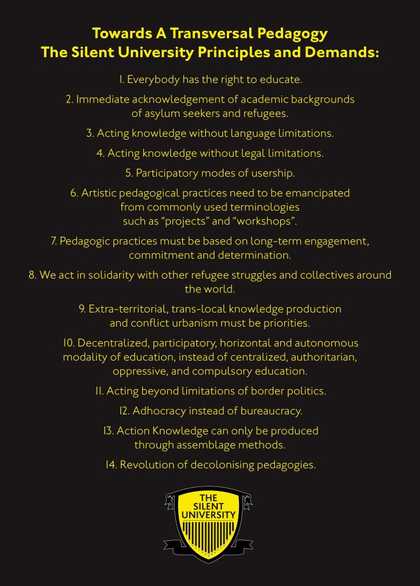
Fig.10
Ahmet Ögüt
‘Towards a Transversal Pedagogy: The Silent University Principles and Demands’, statement published on the website of The Silent University, established 2012
Such lists of individuals feature in another artist’s university project: Ahmet Ögüt’s The Silent University, which was founded in 2012. The deterritorialisation of knowledge and a practical response to political situations are central to The Silent University, such that it can be seen as an update of FIU concerns for present-day needs. Alongside a list of its ‘principles and demands’ (fig.10), the website for Ögüt’s project describes it as:
[A] solidarity-based knowledge exchange platform by refugees, asylum seekers and migrants. It is led by a group of lecturers, consultants and research fellows … [It involves] those that have had a professional life and academic training in their home countries, but are unable to use their skills or professional training due to a variety of reasons related to their status. Working together, the participants have developed lectures, discussions, events, resource archives and publications.31
The Silent University has made use of spaces at institutions such as Tensta Konsthall in Stockholm and the Van Abbemuseum in Eindhoven, but it is also virtual and has been paired with both art and non-art contexts: a move that may again refer to Beuys’s expanded concept of art. While Ögüt is credited with initiating The Silent University on the project’s website, his identification as an artist is not stated there, and no image of him appears. Similarly, although the website features biographies and portrait photographs of lecturers, consultants and fellows affiliated to The Silent University, a number of these are anonymised. Alternative university projects such as this one can be linked to a Beuysian genealogy, although that link is rarely of importance to most of the scholars or students who use or are part of them. Shannon Jackson has reflected on the need for artists’ infrastructural projects to work in the community, and for the artist’s name to remain in the background. On the other hand, she also argues for them to have a presence within canonising narratives (such as those provided by art or performance historians or theorists) that extend into public and academic discourse, which are also necessary for supporting funding applications to enable the projects to come into existence in the first place. Jackson rightly argues that such projects – of which Ögüt’s Silent University is a good example – should and do ‘jump scale’, such that this work is successful when ‘social and artistic imaginaries converge’.32 Bearing this in mind, Beuys’s name, with its associated mythology and far from ‘minor’ proportions in public perception, would, it seems, elide the social aspects of projects overtly connected to it. It is therefore at times arguably better not to mention Beuys, for instance when it comes to such social (art) practices as The Silent University, in order to fulfil the FIU’s potential all the better.33
In co-establishing the FIU, Beuys can be said to have intervened in people’s lives in similarly practical ways as the Silent University is doing. He paid attention to small-scale (educational) institutions, such as the association that is still taking care of his 7000 Oaks in Kassel (see 7000 Oak Trees 1982, Tate AR00745). This was Beuys’s project, begun at Documenta 7 in 1982 and completed by Documenta 8 in 1987, that involved planting 7000 oak trees throughout the city, each paired with a basalt stone. In the case of 7000 Oaks, it was not sufficient just to make the work, but people needed to be found and supported who would ensure that both the material elements and the spirit of the work could last and, if necessary, be adapted.
Beuys repeatedly helped circles of friends in strategic places, like those artists who instituted the Art and Research Exchange in Belfast in 1978, the first rent payment for which was made by Beuys – one possible reason why he listed it among the FIU’s addresses the following year. The self-organised artists’ infrastructure that has emerged from the Art and Research Exchange has involved working with the Belfast School of Art and ensuring that key players could benefit from university employment. This extended community continues to teach through art, sensitising and involving individuals one person at a time, and quietly but effectively (though always precariously) creating the ‘shared spaces’ that politicians in the region are still having a difficult time establishing.34 In 1979 the Belfast-based artist Alastair MacLennan achieved success in setting up one of the first Master of Fine Arts programmes in the UK, and in 1993 he helped students to found Catalyst Arts, an artist-run space established as a post-graduate ‘training ground’ that could sit at arm’s length from the Belfast School of Art. It offered PhD studentships to artists engaging in discourse-dependent, often social practices, allowing them to have a broader, reciprocally direct and indirect effect through networks and collaborations.
A weekly reading and discussion group that I ran at Ulster University in Belfast experienced its own conversion into an FIU-like practice. The group’s subject was art history and theory with a focus on issues resonating in Northern Ireland. It was established in 2007, was open to anyone who wanted to join from inside and outside of the university, and was initially run within the institution. From around 2010 the university began to experience the usual changes that were taking place in neoliberal institutions at this time – access barriers were being installed and convening the group no longer counted as teaching hours. ‘Affiliating’ the initiative with the FIU therefore became a logical step, especially as the FIU had had an address in Belfast. Yet the idea that we might declare this affiliation ‘official’ was not discussed and it seemed unnecessary for those who attended: knowing about the tradition, history and ethos of the FIU was enough.
Stealth practices
Artist-led educational projects often employ other covert strategies – variously named ‘Dark Matter’ or ‘stealth’ practices by Gregory Sholette and writer and curator Maria Lind.35 These are art-related (research) practices that are often invisible – similar to the way that they were hidden as a result of the dictatorial conditions behind the Iron Curtain. They form their institutions experimentally and in doing this can have their advantages and disadvantages, whether the initiatives are temporary or long-term. Hirschhorn presented a clear Beuysian reference in his Spinoza Project and, like the FIU at Documenta 6, conformed to the economics of biennials that favour short-term project-driven modes of creating and receiving art. However, longer-term ambitions to create such institutions, especially if they go beyond the networks of individuals through which the FIU has survived, have been thwarted.36 For instance, Manifesta 6 in Cyprus (2006) was designed to present itself as an art school, instead of a spectacular, short-lived, tourism-intensive European art biennial, and one could argue that this would have constituted a stealth project. The project’s aim of fulfilling local artists’ needs and wishes was apparently not appreciated by those in power, since a counter-educational institution could be expected to harbour and generate critical debate, and this edition of Manifesta was ultimately cancelled.37 As Sholette has observed: ‘[U]nlike a century ago when art aimed to be useful for building a revolutionary society, the aesthetic laboratories and pedagogical experiments of today operate within an ill-defined neoliberal landscape of fractured resistance and temporary anti-enclosures that attempt to remain one step ahead of enterprise culture.’38
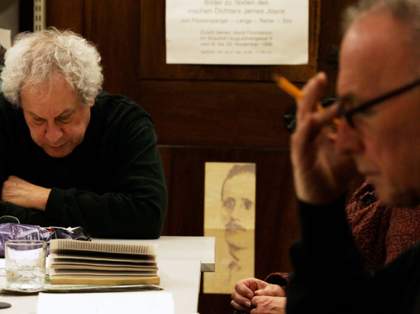
Fig.11
Dora García
The Joycean Society 2013 (still)
An FIU-like to-ing and fro-ing between biennial culture and more sustained, but institutionally relatively invisible, research and art can also be observed in Dora García’s practice. In writing about García, Maria Lind – who hosts The Silent University as director of Tensta Konsthall – considers as a ‘stealth practice’ the reading of Joyce’s Finnegans Wake (1939) at the Zurich James Joyce Foundation. For more than thirty years, this group, which is loosely associated with Zurich University, has met weekly to read Joyce’s book. The group is the subject of The Joycean Society 2013 (fig.11), a 53-minute documentary film by García that shows its members reading together from various editions of the text. In her analysis, Lind considers both the reading group and the film in terms of social practice. The reading group would some time ago have been called the pinnacle of academic activity, with its aim of interpreting what has been called the most difficult book in the literary canon. Now that decisions made by the Bologna Process – a group of higher education ministers from 48 European countries established in 1999 – has made long-term projects in universities all but impossible, it is perceptible how far such an activity sits from something that can ‘count’ in the neoliberal academic system, and I would argue that it therefore comes to be regarded as social practice. In this case Beuys’s move in the direction of the academy is reciprocated or turned the other way by non-art scholars, who must move outside of it in order to continue.
Literary historian Sebastian Knowles has explored why readers of Joyce, such as Beuys and García, may be prominent among those artists who establish university projects. In his 2018 book At Fault: Joyce and the Crisis of the Modern University, Knowles argues that:
Joyce has a lot to teach us in the modern university, if we would only listen to him … If a university is a place of learning, then mistakes must and will happen within it. That’s how all of us learn. If learning is trial and error, then we’ve kept the trial and eliminated the errors. The modern university has lost its way: in its search for rectitude and the comforts of perception, it has failed to attend to its greatest and most vital purpose.39
In light of this, we can see the significance of Joyce’s name being listed repeatedly in counter-educational contexts, including Beuys’s work. Joyce appears to have inspired alternative university structures by writing books that call for collective reading and allow space for trial and error, and that are too demanding and time-consuming for conventional educational institutions that are increasingly geared to faster and faster consumption.
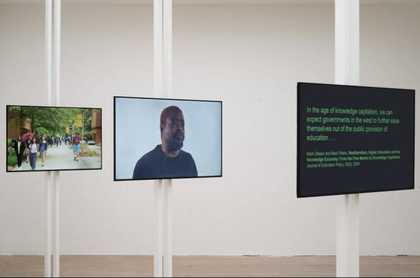
Fig.12
Antoni Muntadas
Installation view of the exhibition Activating Artifacts: About Academia, De Appel, Amsterdam, 2017
Photo © Cassander Eeftinck Schattenkerk
Where, then, can one find one of the most thoroughly researched bibliographies and extensive interview series on the malaise of the public university? The artist Antoni Muntadas has completed and exhibited two series of interviews on the neo-liberal university (About Academia I and About Academia II), augmented by quotations from well-cited literature – from university management texts to those by cultural theorists such as Judith Butler and Michel Foucault. About Academia I was presented in 2011 at the Carpenter Center for the Visual Arts at Harvard University, and About Academia II was shown in Muntadas’s 2017 exhibition project Activating Artifacts: About Academia, which traced further the genealogy of educational institutions that were innovative in the area of counter-education, such as the Bauhaus.40 In Activating Artifacts: About Academia, Muntadas’s video interviews and textual quotations appeared on screens in the gallery space (fig.12). It was curated by participants of the curatorial programme of the De Appel art space in Amsterdam in partnership with the University of Amsterdam’s art history department in 2017, when De Appel as an institution was homeless, and could therefore be regarded as a logical step into the university.
This example is among many that indicate the fluid interchanges that still exist between artists’ research and exhibition projects, art spaces as educational organisations, and universities as art spaces, both in line with and beyond Joseph Beuys. It highlights that hybrid formats for manifesting art projects, including exhibitions and publications, are suitable for reflecting on university systems. Muntadas clearly carries on the FIU’s work in that regard, looking to strengthen his project’s affiliation with art history and in doing so making it address both art and the social imaginary, therefore ‘jump[ing] scale’, to use Jackson’s phrase again.
Challenging institutions: The network evolves
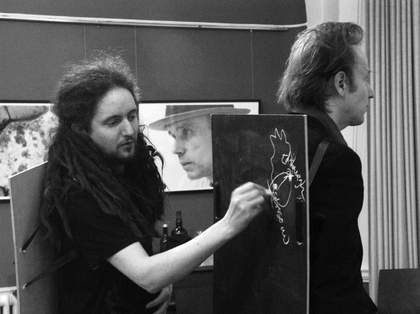
Fig.13
Art / not art (David Dobz O’Brien, left, and Fergal Gaynor, right) at a Beuys symposium at the Goethe Institute, Dublin, 2006
Regarding such work as ‘jumping scale’ also makes it possible to see connections between clusters of people, art and educational institutions and what the FIU became over time, once Beuys had abandoned the idea of fixing it institutionally. To give another example that returns to some names and institutions already mentioned: my Amsterdam students’ university protest exhibition Strijd ∞ (Fight ∞) hung in the re-appropriated Maagdenhuis (Senate House) of the university in spring 2015 and documented the history of student protests that had been held in the Maagdenhuis itself since 1969. The exhibition was welcomed by Waldo Bien and the Amsterdam contingent of the FIU, who supplied us with a special Amsterdam edition of the FIU stamp in digital form, modified to accommodate the three crosses of the city and university logos. Ahmet Ögüt and Charles Esche, director of the Van Abbemuseum, then included the Strijd ∞ exhibition in Ögüt’s retrospective at the museum.41 Esche’s own ProtoAcademy, which ran in Edinburgh from 1997 to 2001, has already been mentioned above in the list of artist-led university projects. He also co-curated Cork Caucus in 2005 with Annie Fletcher and the artist collective Art / not art (David Dobz O’Brien and Fergal Gaynor), as part of Cork’s bid for European City of Culture. Art / not art made direct reference to the FIU in their ‘educational scheme’ for Cork Caucus, which itself had a natural but tenuous connection to University College Cork as this was also Fergal Gaynor’s place of non-academic employment (fig.13).42
In addition to being hosted by Esche at the Van Abbemuseum, Strijd ∞ was presented at the ‘Global Critical Pedagogies’ conference at the University of Amsterdam in 2018, where I spoke on the same panel about Beuys and the FIU’s legacy. A third element of this panel included the presentation of an art and documentary work, Kaba Kopya / Rough Copies 2018 by Kathryn Karaoglu Hamilton and Oscar Durand. This film focuses on Turkish academics who were among the 2000 who lost their jobs and have faced trials in Istanbul because they signed the Peace Petition against violence towards Kurdish people.43 The seven Solidarity Academies established by these academics have developed alternative educational formats, such as reciprocal learning and collaborative knowledge production. These scholars and their students use various buildings in their cities and survive with their families on the basis of salary-sharing: those who did not sign the Peace Petition, and who are therefore still employed by their universities, share their salaries with colleagues who were dismissed. Artworks such as Kaba Kopya / Rough Copies can, therefore, also highlight counter-educational projects and establishments that may not in themselves be ‘artistic’ (echoing Beuys’s expanded concept of art). In various ways, the projects and overlapping networks traced here share with Beuys’s FIU the element of conceptual or financial support for critical and dissident academics – from the time of the Cold War to today.
The case of salary-sharing in Turkey shows how important it is for counter-educational groups to maintain links with those who are in public university employment, whether or not those groups relate directly to Beuys or the FIU. The advantages of working inside or outside public institutions, or at an ‘interstitial’ or internal distance from them, to use philosopher Simon Critchley’s term, will differ from case to case.44 Given the discrediting, defunding and even closing down of academic institutions in many countries in recent years – the Central European University in Hungary is but one example – cutting ties with the institution may still be tempting or inevitable, as it was in the case of Beuys’s dismissal from his position at the Düsseldorf Academy.45
Yet it is also dangerous to forsake the university completely, even when one’s analysis might be that the institution in question is already ‘finished’, as Jalal Toufic puts it in his conceptualisation of art academies, quoting Gilles Deleuze. Toufic is the former director of ALBA, the Lebanese Academy of Fine Art. His mission statement for the academy outlines its ambition to provide students with temporary autonomous zones, to instil them with a ‘shit detector’ and to teach them to appreciate failure, among other approaches – all of which show an affinity with FIU values. However, Toufic’s statement closes as follows:
Gilles Deleuze wrote in May 1990: … ‘But… these institutions are finished, whatever the length of their expiration periods… The societies of control… are in the process of replacing the disciplinary societies.’ While Deleuze’s prescient words have become more manifest in our day, a quarter of a century after he wrote them, they were obscured in the context of Alba’s School of Visual Arts by the accidental problems that had beset it from around the time he wrote his text till my assumption of its directorship three years ago. As the school’s new director, I considered (and continue to consider) that by fixing the largely accidental problems that have beset it for some time, the problems that cannot be fixed by any administration and faculty, since they are symptoms of the ongoing transition from disciplinary societies to societies of control, would come to the fore and become clearer, this making it easier to contribute to ‘new forms of resistance against the societies of control’.46
Even, or especially, when the institution is seen from ‘above’ and ‘inside’, the aim of caring for and fixing it is to make the controlling system appear precisely that – controlling and unfixable – while still attempting to provide students with what they and their art are in need of. Coetzee did not suggest forsaking the ‘day job’ in the universities that ‘have redefined themselves out of existence’, advocating the example of Polish academics in the bad old days who ran philosophy seminars ‘in [their] living room, outside office hours, outside the institution’.47 It is possible to ‘merely’ direct one’s caring, educating energies where it is possible for them to be applied, even if the controlling ‘inside’ may not be strengthened in the process, and even if the academic (or artist) ends up engaging in self-exploiting behaviour, continuously over-delivering by the system’s standards. In 1972 Beuys issued a postcard multiple that read: ‘Ich kenne kein Weekend’ (‘I know no weekend’).48 The open question is in this regard remains: whose needs is one meeting in approaching things in this way?
Beuysian echoes
In many countries, the times we live in now are the bad new days, to put a twist on Coetzee’s phrase. Artists like Tania Bruguera, who perceive themselves in the Beuysian tradition, are developing institutions as vehicles of international collaboration, fundraising and local safeguarding.49 Where there are universities that wish to function as ‘arbiters of truth’, as ‘systems and instruments of verification’,50 they arguably need to be used in accordance with their own lofty ideals and thus strengthened, so that they can continue to be used thereafter.
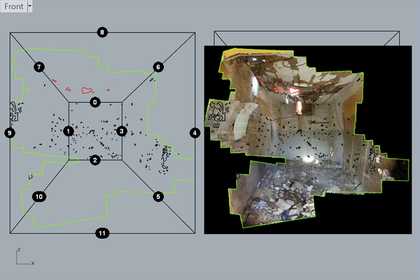
Fig.14
Forensic Architecture
Image from a reconstruction of a drone strike in Miranshah, Pakistan, 2014
© Forensic Architecture
The phrases quoted here are used by Eyal Weizman, whose research group Forensic Architecture is based at Goldsmiths, University of London and tracks international, state-sponsored crimes or collusion, usually through publicly available evidence or material provided by victims’ families or NGOs (see fig.14). In doing so, Forensic Architecture both demands that the university fulfils its function as an independent arbiter of truth, and tests what is possible in institutions today. It is clear that the FIU, while it also consisted of a group of affiliated researchers/activists, would fall short of providing sufficient status and institutional support for such vital work as that carried out by Forensic Architecture. Having said that, Weizman states:
My political imagination is one in which architecture and politics come together to make something that I call the political plastic (after Joseph Beuys), which is a kind of viscous medium in which forces and structures, global flows, forms, and trajectories create a world that undergoes a constant process of formation.51
In outlining his mission in such a clearly Beuys-related way, Weizman appears to dissociate the artist from counter-institutions per se, while implying that a ‘process of formation’ continues to take place that lets Beuys’s idea of ‘social sculpture’ materialise wherever one ‘create[s] a world’.52 Weizman is also one of very few social practitioners today who will mention Beuys by name in association with their work. For instance, Weizman is the only author in the book Former West: Art and the Contemporary after 1989 (from which the above quotation is taken) who mentions a connection with Beuys. It is fair to say that many other contributors to Former West, including authors writing about university protests and social practice art projects, let a sensibility shine through that is not far from a Beuysian or FIU one.53 However, naming Beuys is another matter. It is not a surprise that establishing a legacy for the FIU, as this article aims to do, involves analysing work that was carried out within the systems of verification that a public university, however embattled, can provide.
An ongoing revolution
It is clear that Beuys has long been part of the canon of art history and is to be found at the core of many art institutions and practices in its sphere, such as museums, restoration, the art market and formal art education. Likewise, FIU co-founder Klaus Staeck was elected three times as president of the Academy of Art, Berlin between 2006 and 2015, and was subsequently made honorary president. It is important to add that Beuys himself always regarded the museum as an institution where his work, including performances, lectures and discussions, had a place. He formed connections with those who were ready to institutionalise his ideas and their own for decades to come – be it through Belfast studio cooperatives or Kassel city politics.
The heterogeneous examples discussed here show that Beuys’s work was, and still is, able to ‘jump scale’ and address both artistic and social imaginaries. Social practitioners often seek to collaborate with universities,54 as De Appel and Muntadas did – and the people involved increasingly develop dual biographies, occupying each other’s spaces.55 In their book on the politics of study, Sidsel Hansen and Tom Vandeputte conclude:
If the academy is in crisis, this is not only a matter of austerity politics, of increasing tuition fees or problematised access to education, or of the logic of evaluation and measurement which presses in on universities and art schools alike. It is also a crisis of our understanding of the academy and of education as such. This crisis prompts us to rethink practices of learning and inquiry beyond the constraints of inherited institutions, but also beyond the false alternatives to them. The question is, then, how we can invent spaces and methodologies of study that do not leave the present intact but manage to break it open.56
Since Beuys and the FIU, many artists have devoted their attention to this question – and have found ever new answers, calibrated to their individual times and contexts, thereby contributing to an archive of counter-education that is far from the self-similar appearance of multiple La Rivoluzione Siamo Noi posters. The initiatives considered here as part of the genealogy of the FIU are expanded (art)works and appear as constructions in different scenarios, which include public universities and art academies. As curator Nato Thompson put it in his essay ‘Articulations of Artist-Initiated Organizations’:
the scope of this work points toward a complex landscape of competing lenses, geopolitical conditions and audiences. While the forms of legibility remain complex, the growth of artist-initiated organizations points toward a vast interest stirring at the cross-section of art, activism and social infrastructure.57
These projects that can, but often do not want to, claim a Beuysian legacy are living their own lives today, and may profitably be recuperated as part of a diverse FIU genealogy that changes our view of the FIU itself in its original context among dissident and counter-educational initiatives. Narratives around artist-initiated organisations – such as the one presented here and the narrative established by the La Rivoluzione Siamo Noi multiples when displayed at Tate and elsewhere – may be helpful today in letting social and artistic imaginaries converge and encouraging a collective momentum. There are at least as many social art practices to be developed and art histories to be written as there are posters to be copied and exhibited.

